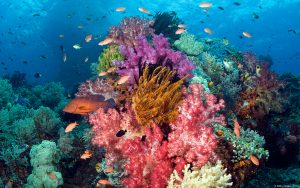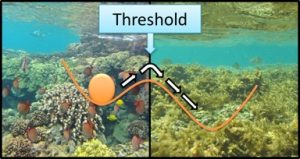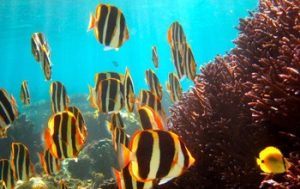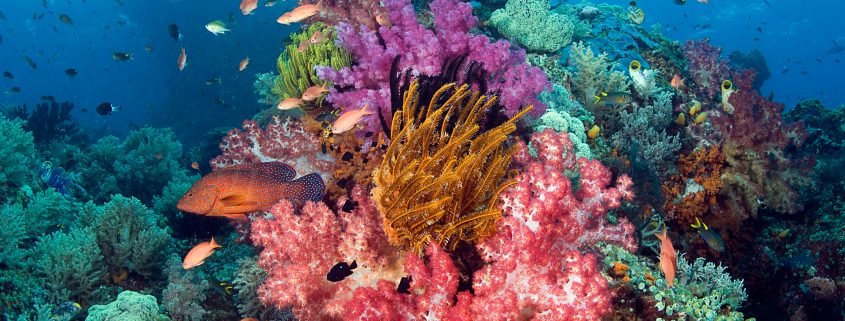Fish Avoid Coral Habitats Due to the Presence of Algae
By Leila AtallahBenson, SRC masters student

A thriving coral reef community
The issue
Coral reefs are one of the most diverse, beautiful ecosystems in the world. They contain an array of marine life, swimming around magnificently colored coral. Unfortunately, due to climate change, these once thriving ecosystems are changing. Visible shifts in coral communities usually start with the increasing presence of algae (Figure 2). Although algae are natural and important in healthy coral communities, too much of certain algae can outcompete coral-dwelling symbionts. With decreased coral cover and increased nutrients due to human factors, algae are quickly filling in extra space decreasing coral chances of regaining cover. Corals provide habitat, food, and recruitment cues for many coral reef organisms, and an algae shift will not only hurt the corals, but coral reef communities as a whole.

Threshold of a coral reef community to an algae dominated one.
Experiment and results
Earlier this year researchers wanted to know if associations between coral reef fishes and corals were the same with and without algae present. Butterflyfish, which are known to have a high dependence on corals for food, were exposed to corals with and without two species of algae on them (figure 3). 96% of associations between the fish and coral occurred on corals with no algae. When exposed to both visual and chemical cues, most butterflyfish species preferred to stay where seaweed was not. When the algae were physically removed, new fishes were exposed to the lingering algae chemical cues. One algae attracted butterflyfish, Sargassum polycystum, while the other, Galaxaura filamentosa, a highly toxic algae to corals, still caused fish to avoid the reef. The control reef with no algae or chemical cues still attracted fish.

Butterflyfish in Lord Howe, Australia.
These experiments tell us that butterflyfish use both visual and chemical cues during habitat interactions. Visual algae cues make it more difficult for fish to see coral polyps, and/or to pick up on their chemical cues. Chemical signatures of corals may be altered via stress, seaweed chemicals, or types of defense, given certain algae presence. Coral nutritional value may be decreased when exposed to algae, and these cues may warn butterflyfish from wasting energy.
Outcomes
This is bad news for both corals and butterflyfish. If the majority of butterflyfish feeding occurs on corals without seaweed presence, these healthier corals will have to spend lots of energy in repairing and maintaining their polyps. With increased algal cover, feeding will only intensify on these healthy coral colonies. The increased pressure may lead to decreased efficiency or even mortality. When these corals collapse, butterflyfish will be forced to utilize corals with algae present, thus decreasing their efficiency. This is but one of many examples showing how climate change can drastically effect habitats, forwardly altering entire communities. It’s imperative for people to work together to decrease our carbon footprint and slow the changes of climate change in order to protect these wildly diverse ecosystem.
References
Brooker, R.M., Brandl, S.J., Dixson, D.L. 2016. Cryptic effects of habitat declines: coral-associated fishes avoid coral-seaweed interactions due to visual and chemical cues. Scientific Reports 6.




Leave a Reply
Want to join the discussion?Feel free to contribute!